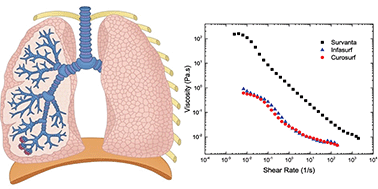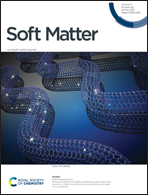Bilayer aggregate microstructure determines viscoelasticity of lung surfactant suspensions†
Abstract
Neonatal respiratory distress syndrome (NRDS) is treated by intratracheal delivery of suspensions of animal-derived lung surfactant in saline. Lung surfactants are extracted via organic solvents from animal lung lavage, followed by solvent removal and surfactant re-hydration to form multi-bilayer particles suspended in saline. Following intra-tracheal administration, the surfactant suspension spreads throughout the lungs by surface tension gradient induced flow; the spreading rate is limited by suspension viscoelasticity. Here we examine the rheology of three clinical lung surfactant suspensions: Survanta (bovine lung), Curosurf (porcine lung), and Infasurf (calf lung). These surfactants have widely different rheological properties that depend on the lipid composition and bilayer organization. The steady shear viscosity is related to the bilayer particle volume fraction as for a suspension of hard spheres, but the lipid volume fraction is not simply related to the mass loading. Optical and electron microscopy and small angle X-ray scattering show that the viscosity variation is due to the temperature and composition dependent bilayer aggregate shapes and internal particle organization. Survanta forms crystalline bilayers at 37 °C, resulting in high aspect ratio asymmetric particles. Infasurf forms aggregates of unilamellar vesicles containing water pockets, while Curosurf forms onion-like multi-layered liposomes. While the mass loading of the three clinical surfactants is different, the different bilayer organization causes the particle volume fractions to be similar. Adding polyethylene glycol dehydrates and partially flocculates the bilayer aggregates in all suspensions, leading to smaller particle volume fractions and a reduced suspension viscosity even though the solvent viscosity increases almost six-fold.



 Please wait while we load your content...
Please wait while we load your content...
